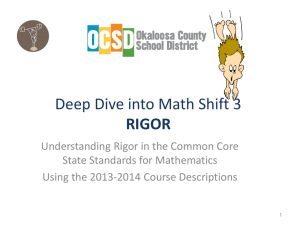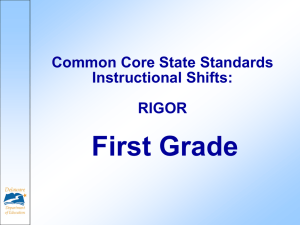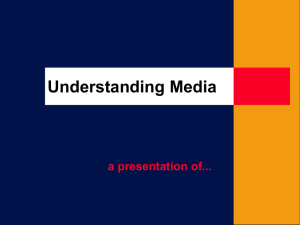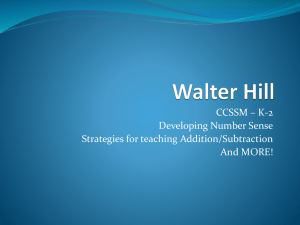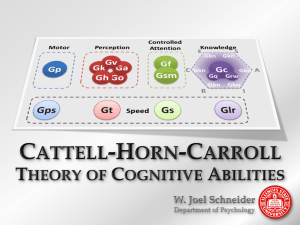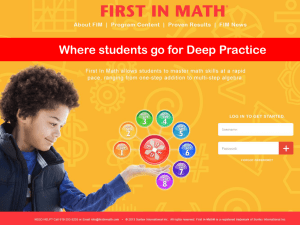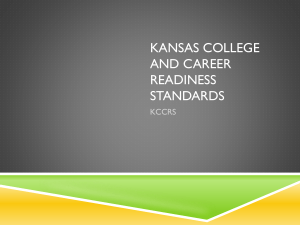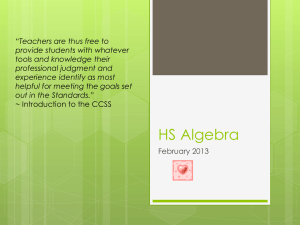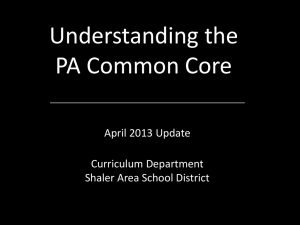May 2nd Rigor Elementary
advertisement
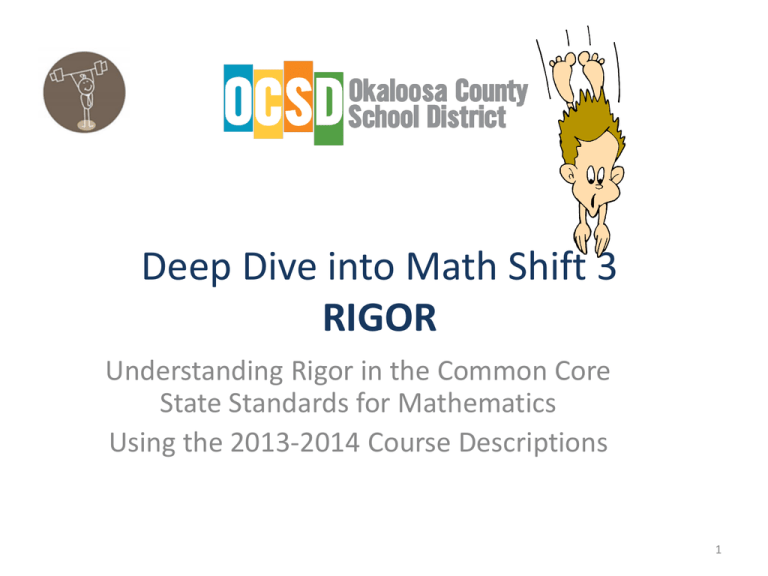
Deep Dive into Math Shift 3 RIGOR Understanding Rigor in the Common Core State Standards for Mathematics Using the 2013-2014 Course Descriptions 1 Shift #3: Rigor What is meant by rigor? • The CCSSM require a balance of: Solid conceptual understanding Procedural skill and fluency Application of skills in problem solving situations • Pursuit of all three requires equal intensity in time, activities, and resources. RIGOR Today’s Agenda Rigor in the CCSSM We will... 1. Discuss and Find evidence of Rigor within the Common Core Standards 2. Look specifically at fluency and the role it plays in math instruction 3. Discuss conceptual understanding and differentiation 3 Fluency: What is it? Skill in carrying out procedures flexibly, accurately, efficiently and appropriately What the Student Does… What the Teacher Does… •Spends time practicing, with intensity, skills (in high volume) •Pushes students to know basic skills at a greater level of fluency •Focuses on the listed fluencies by grade level •Uses high quality problem sets, in high volume 4 How do we address rigor while building fluency? Rigor Breakdown - Sprints - Fluency in Action(6:07) http://www.engageny.org/resource/nti-november-2012-rigorbreakdown-sprints-fluency-in-action 5 Deep Understanding What is it? Comprehension of Mathematical Concepts What the Student Does… What the Teacher Does… •Shows mastery of material at a deep level •Responds to student answers by eliciting student explanations and reasoning •Articulates mathematical reasoning •Demonstrates deep conceptual understanding of priority concepts •Ensures that all students reach understanding •Views concepts being taught as a coherent continuum instead of as isolated topics 6 Application What is it? Bringing mathematical skill and understanding together and applying it to real-world situations and in new contexts What the Student Does… What the Teacher Does… •Applies math in other content areas and situations, as relevant •Applies math content to other content areas (i.e. science) •Chooses the right math concept to solve a problem when not necessarily prompted to do so •Provides students with real world experiences and opportunities to apply what they have learned 7 Rigorous Group Discussion 1. Share examples of relevant, real-world experiences you use to make important connections to the concepts you teach. 2. How do these applications relate back to both fluency and conceptual understanding? 8 Rigor Addressed in the Standards • Conceptual Understanding: 3.NF.1.1 Understand a fraction 1/b as the quantity formed by 1 part when a whole is partitioned into b equal parts; understand a fraction a/b as the quantity formed by a parts of size 1/b. • Procedural Skill and Fluency: 5.NBT.2.5 Fluently multiply multi-digit whole numbers using the standard algorithm. • Application: 4.MD.3.7 …Solve addition and subtraction problems to find unknown angles on a diagram in real world and mathematical problems… 9 Rigor Requires Balance Conceptual Understanding + Procedural Skill and Fluency + Application = RIGOR 10 Evidence of Rigor in the Standards key words within the standards Conceptual Understanding Understand Describe Relate Justify Recognize Explain Represent Solve Interpret Use Identify Procedural Skill and Fluency Fluently Fluency Application Solve Real World Problem Mathematical Problem Word Problem Apply Model(ing) 11 RIGOR is a Balancing Act RIGOR 12 Key Fluencies Grade Standard Key Fluency K MACC.K.OA.1.5 Add/subtract within 5 1 MACC.1.OA.3.6 Add/subtract within 10 2 MACC.2.OA.2.2 Add/subtract within 20 MACC.2.NBT.2.5 Add/subtract within 100 (pencil and paper) 3 MACC.3.NBT.1.2 Add/subtract within 1,000 MACC.3.OA.3.7 Multiply/divide within 100 4 5 6 MACC.4.2.4 Critical Area #1 Add/subtract within 1,000,000 Develop fluency with efficient procedures for multiplying whole numbers MACC.5.NBT.2.5 Multi-digit multiplication Critical Area #1 Developing fluency with addition and subtraction of fractions MACC.6.NS.2.2 Multi-digit division MACC.6.NS.2.3 Multi-digit decimal operations 7 MACC.7.EE.2.4a Solve px + q = r, p(x + q) = r 8 MACC.8.EE.3.8b Solve simple 22 systems by inspection 13 Kindergarten Fluency Progression Represent addition and subtraction with objects, fingers, mental images, drawings, sounds (e.g., claps), acting out situations, verbal explanations, expressions, or equations (K.OA.1.1). Solve addition and subtraction word problems (K.OA.1.2) Fluently add and subtract within 5 (K.OA.1.5) 14 Grade 1 Fluency Progression Add and subtract within 20 (1.OA.3). Demonstrate fluency for addition and subtraction within 10 (1.OA.3.6). 15 Grade 2 Fluency Progression Fluently add and subtract within 20 using mental strategies (2.OA.2.2). Fluently add and subtract within 100 using strategies based on place value, properties of operations, and/or the relationship between addition and subtraction (2.NBT.2.5). 16 Grade 3 Fluency Progression Fluently add and subtract within 1000 using strategies and algorithms based on place value, properties of operations, and/or the relationship between addition and subtraction (3.NBT.1.2). Interpret products and quotients of whole numbers (3.OA.1.1-3.OA.1.4) Apply properties of operations as strategies to multiply and divide (3.OA.2.5) Fluently multiply and divide within 100 using strategies such as the relationship between multiplication and division (3.OA.3.7). 17 Grade 4 Fluency Progression Fluently add and subtract multi-digit whole numbers using the standard algorithm (4.NBT.2.4). Develop fluency with efficient procedures for multiplying whole numbers; understand and explain why the procedures work based on place value and properties of operations; and use them to solve problems (Critical Area #1). 18 Grade 5 Fluency Progression Fluently multiply multi-digit whole numbers using the standard algorithm (5.NBT.2.5). Develop fluency in calculating sums and differences of fractions, and make reasonable estimates of them (Critical Area #1) 19 Rethinking Rigor • Building Confidence through Problem Solving • Grades 3-5, Math, Number Fluency https://www.teachingchannel.org/videos/buildingmath-confidence 20 Group Discussion Where was the rigor? How do you differentiate instruction in your classroom? What instructional shifts should occur in our classrooms? 21
